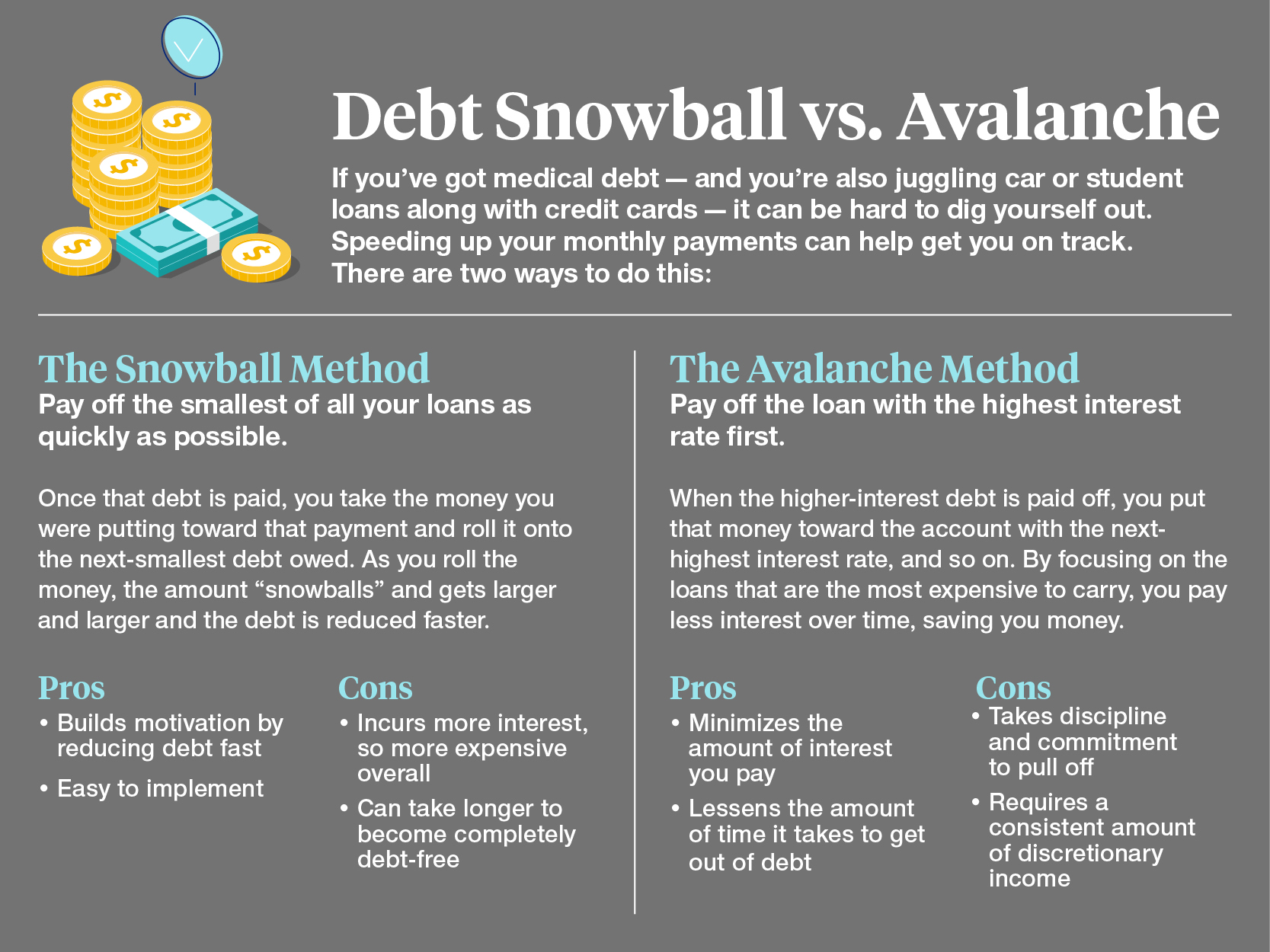How to Pay Down Your Medical Debt
With rising health care costs, it’s all too easy to find yourself racking up debt for medical tests or procedures. Here are expert tips to help you reduce your expenses.

Medical debt is a mounting problem. Roughly 20% of U.S. households carry medical debt, according to the Consumer Financial Protection Bureau. And a June 2022 report from the Kaiser Family Foundation found that in the past five years, more than half of U.S. adults have reported that they’ve gone into debt because of medical bills.
“Health care prices in the U.S. are both high and unpredictable,” says Caitlin Donovan. She’s the senior director of public relations at the National Patient Advocate Foundation. “At the same time, insurers have been shifting an increasing percentage of the cost of care onto consumers through higher deductibles and other cost-sharing mechanisms. I’ve spoken to patients who decided not to pursue treatment, rather than place their families into debt.”
And unfortunately, medical debt is the most common cause of personal bankruptcy in the U.S. That’s according to a study published in 2019 by the American Public Health Association.
“It occurs when people don’t have insurance, or when they have insurance plans with very high deductibles and have an unexpected health care event,” says Cindi Gatton. She’s the vice president of Health Advisory at Caribou and a board-certified patient advocate.
Medical debt can also be incredibly stressful, impacting your mental health. A 2018 report by the American Psychological Association found that nearly 3 in 5 Americans (57%) were stressed about medical bills.
To help you chip away at medical debt — and prevent it — here are some expert tips.
There are tools to help you find the cost of a procedure before you have it so that there are no surprises. Check out Guroo.com or FairHealthConsumer.org to start comparing costs.
Tips to help you pay down medical debt
Tip #1: Delay before you pay
“About half of the medical bills we see have errors in them,” says Donovan. “One of the most common mistakes is providers billing patients directly, rather than submitting to the insurance company. That means patients are confronted by astronomical bills that they do not actually owe.”
Donovan advises that before you pay anything, wait for your explanation of benefits (EOB) — the document that comes in the mail that says “This is not a bill.”
“The EOB will tell you that your insurer has received a claim and how much you owe,” she says. “By comparing the EOB to the bill you receive, you can easily check to make sure the two amounts align.”
Tip #2: Look for financial assistance
“Almost all hospitals have a financial assistance program,” says Donovan. “And if you qualify, your debt will lessen, if not disappear. Charities and nonprofits also may exist that can help you as well. You are not alone.”
Some financial assistance programs that you may qualify for include the HealthWell Foundation and Accessia Health.
Tip #3: Avoid using a credit card
“Medical debt is not the same as credit card debt … until you put it on a credit card,” says Donovan. “At that point, it’s seen as unsecured debt and could affect your credit score. You will also be subject to high interest rates.”
Instead, see if you can negotiate a billing plan directly with the hospital that you can easily manage monthly, suggests Donovan.
Tip #4: Ask for the cash price
“Sometimes it may be less than the cost of using your insurance, especially if you have a high deductible and don’t expect to meet it during that plan year,” says Donovan.
She explains that medical providers are often willing to negotiate a lower cash price because they get paid upfront. This means they don’t need to go through the administrative hassle of working with insurance.
How to avoid overpaying for medical care to start with
Tip #1: Go to imaging clinics and urgent care, not the hospital
“The prices at imaging clinics are often about 50% lower than imaging services in a hospital,” says Gatton. “Even if you have insurance, using an imaging clinic will stretch your health care dollars further with the added benefit that it’s often easier to schedule and more convenient.”
She adds that urgent care facilities often post basic prices online. And if your medical need isn’t an emergency, you have time to see what’s available.
“Too often we seek care at high-cost facilities without checking to see if there might be lower cost options available,” says Gatton. “And always ask if a provider has a cash discount.”
Tip #2: Use an HSA
“Heath savings accounts, known as HSAs, are special savings accounts that allow you to use pretax dollars to pay for future health care expenses,” explains Gatton. “The money can be invested, just like a 401(k) for retirement. And withdrawals [for qualified medical expenses] are also tax-free. This way you can build a nest egg for when you do have an unexpected health care event. Especially if you need to meet your out-of-pocket maximum before your care is covered at 100%.”
HSAs are available only to people with high-deductible health plans. For 2022, a high deductible is defined as at least $1,400 for an individual or $2,800 for a family.
The contribution limits for 2022 are $3,650 for an individual and $7,300 for a family. Individuals over age 55 can contribute an additional $1,000 beyond these limits, according to Healthcare.gov.
Tip #3: Stay in network
The best and most important thing you can do is stay in network.
“The largest bills we see are from people who are either uninsured or who went out of network, especially before the implementation of the No Surprises Act,” says Donovan. The No Surprises Act makes it easier for consumers to understand the cost of health care services before they’re billed. And it prevents you from having to pay a surprise out-of-network bill.

Tip #4: Shop for low-cost care
One of the best ways to avoid medical debt is to shop around for deals on your medical expenses.
There are many tools available to find low-cost care. Optum Perks helps you find what you could pay for a prescription without insurance and offers discount coupons for medications. Turquoise Health is a great resource for finding the cost of tests or procedures near you.
Tip #5: Know your insurance out-of-pocket maximum each year
Even without an HSA, Gatton suggests that you set aside an amount each month that goes into your “rainy-day account” to pay for expenses when the unexpected occurs.
“You can still utilize payment plans with health care providers, but some of the stress is lessened when you know you have your out-of-pocket maximum in the bank,” she says.
Tip #6: Know your plan’s benefit structure
“Make sure you get any referrals or prior authorizations you need before you go forward with a new provider or treatment,” says Donovan. “Insurers can and will deny coverage if you don’t follow the rules.”
Tip #7: Use telemedicine services
“Once you have a relationship with a primary care doctor who knows you and knows your health history, many issues can be treated via telemedicine,” says Gatton. “In the absence of your own PCP, many insurance plans offer telemedicine services at prices that have much lower costs than going to urgent care.”
Additional sources
Medical debt in the U.S.: Consumer Financial Protection Bureau
Health care debt survey: Kaiser Family Foundation
Medical debt and personal bankruptcy: American Journal of Public Health (2019). “Medical Bankruptcy: Still Common Despite the Affordable Care Act”
Medical debt and mental health: American Psychological Association
Financial assistance programs: HealthWell Foundation and Accessia Health
HSA contribution limits: Healthcare.gov